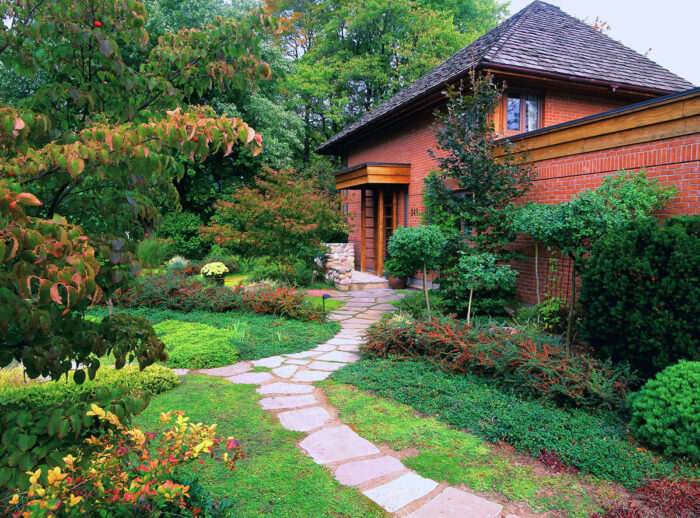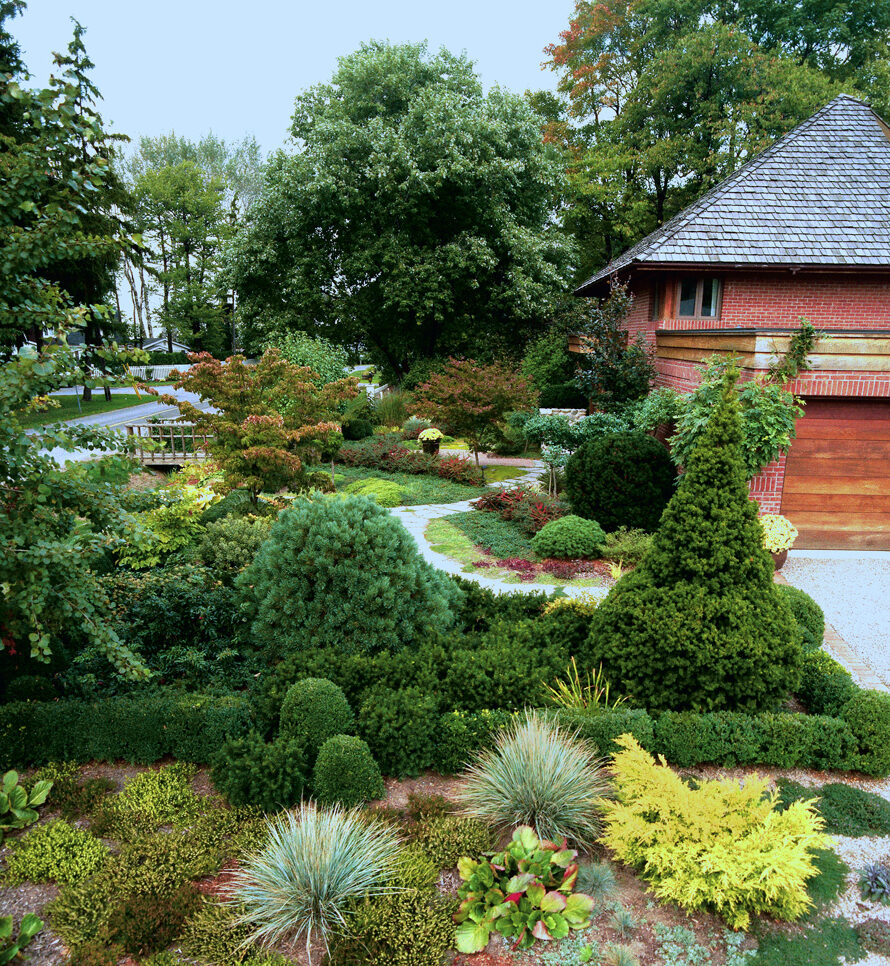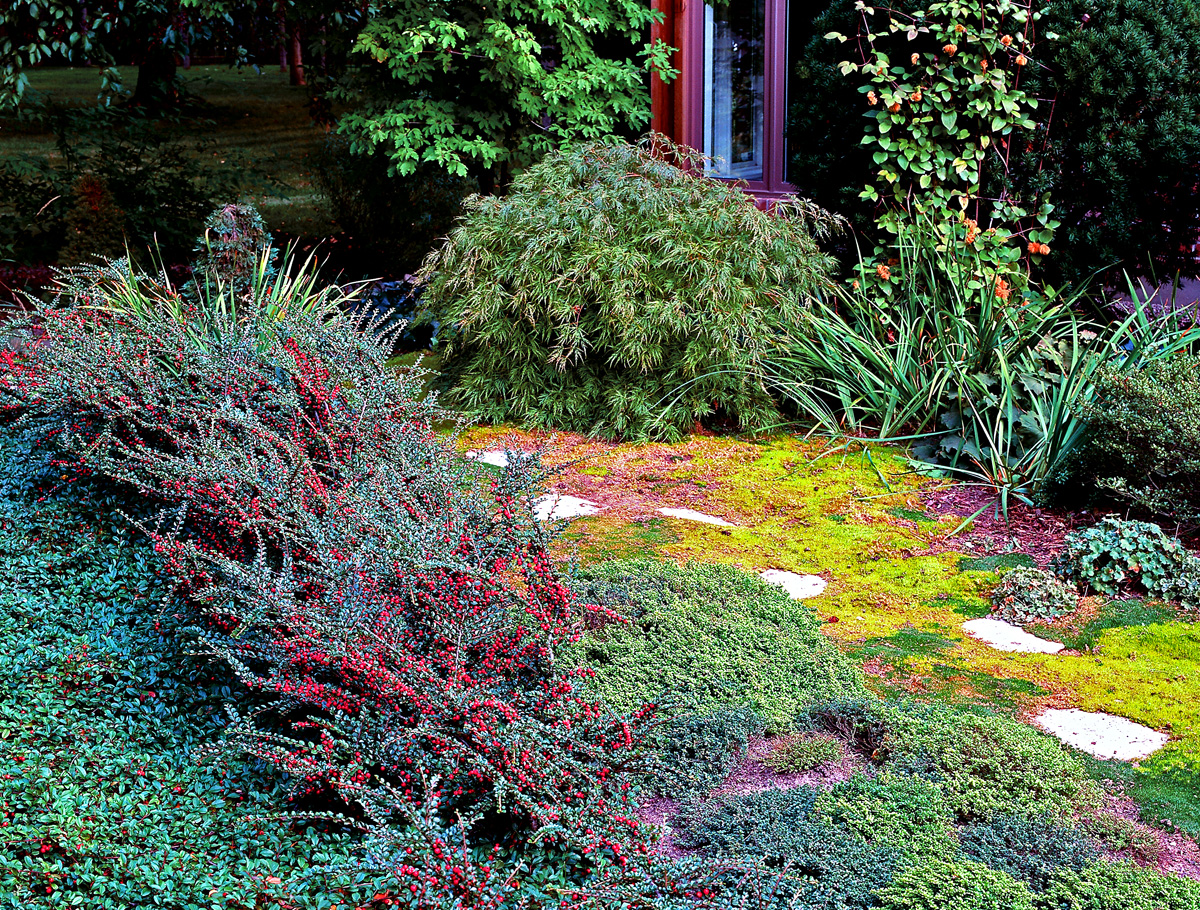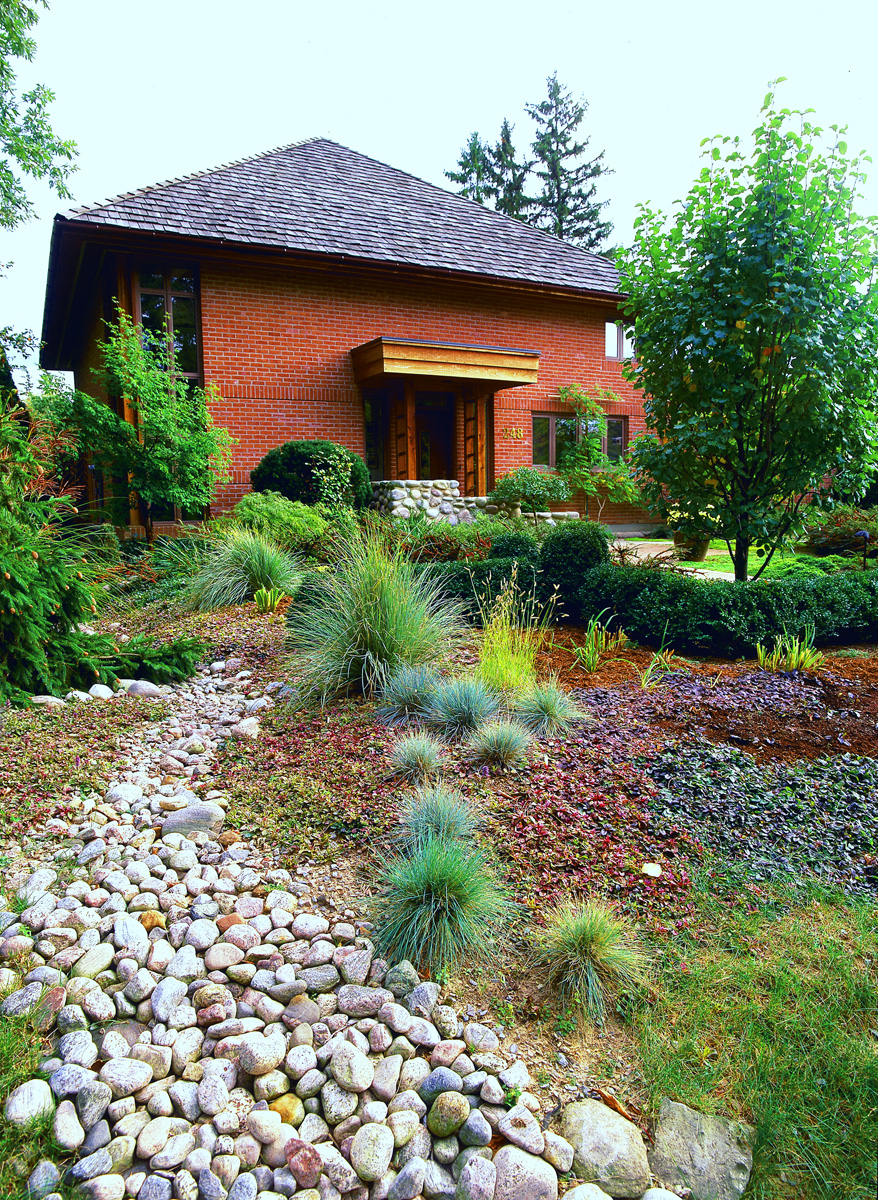
Apprehension grew in our conservative neighborhood the day the crane arrived. Those who saw it dangling 48-foot posts above our building lot could be forgiven for thinking that another monster house was under way. Such fears, however, were soon allayed. The retirement house we built, if unconventional in structure, is actually quite small and blends well with its surroundings. But curiosity was again aroused when neighbors, stopping by to chat as I began planting the front yard, learned that there would not be any lawn.
Foregoing a lawn was not a rash decision, or a political or environmental statement. Nor did we have any illusions about lower maintenance. Rather, it was a practical response to space constraints. Our previous garden had been 75 feet by 200 feet; this new space is just 25 feet by 75 feet. Omitting a lawn simply allowed for much more room to garden.

Occupying the house at Christmas, Jeanette and I spent the rest of the winter planning. Our goal for the front yard was to create an orderly yet natural-looking garden that would be of interest both from the street and from the house, and over all four seasons, including the long Canadian winter. In order to accomplish this, we relied on form, texture, and long-lasting foliage, with flowers playing a supporting role. We also varied the height of our plantings to create greater topographic interest, and chose plants that complemented the faintly Asian character of our brick and cedar house.
Paths lead the way
Spring came, and even the cat was leaving muddy footprints everywhere, so our first priority was to put in a solid path from our front door to the road. Fortunately, there were enough bricks left over from construction of the house for a path. But we still needed another, longer path to connect our new brick path with the gravel driveway at the side.
As luck would have it, a neighbor was breaking up his patio, and he had no use for the stones. Their random shape allowed for a more sinuous, curving path, which pleased us, providing, as it does, a contrast to the long, straight facade of the house. In addition to reducing muddy footprints, these paths also serve to break the garden into smaller areas, which proved helpful as we were deciding on plant groupings.
A low hedge of boxwood defines the garden
We wanted to define the garden area and to give the empty yard some living structure, so we planted a hedge of boxwood (Buxus sempervirens). At the same time, we wanted the eye to be able to move beyond the hedge, so we kept it low—only about 15 inches tall. To prevent it from becoming boring, we punctuated the hedge with little clusters of taller specimens of box in various shapes and we interrupted the longest stretch with an opening at its midpoint.

I used a few extra stones from my neighbor’s patio to form the beginnings of a connecting path toward this opening. This path, however, disappears almost immediately, enveloped in a sea of low-growing Veronica whitleyi, with its wavy, gray-blue foliage. Faux paths like this one help create a sense of something beyond, adding a touch of mystery, which is difficult to achieve in such a small space.
A shrubby backbone links the garden from end to end
Thus far, the stone path was the only fluid line in the garden. We wanted more curves—as well as varied plant heights—to offset the rigidity and uniformity of house and hedge. We started with a swath of rockspray cotoneaster (Cotoneaster horizontalis) weaving its way through the garden lengthwise, crossing both paths and giving the yard its backbone. We reinforced the rockspray cotoneaster with a band of low-growing C. dammeri beside it. These shrubs, in addition to providing flowers in the spring, berries in the winter, and leaves of contrasting textures throughout the year, also serve to link the different parts of the garden, making them all feel a part of the whole.
With the major lines of the garden established, the project began to feel a bit more manageable. We began to fill in, both reinforcing the existing lines in the garden, and adding new ones. For example, we used moss and stepping stones in places to create a sense of passage—sometimes real and sometimes illusory.
At the northern edge of the property, a problem became an opportunity. Despite a great deal of shoveling, I still had not gotten the level right here nor worked out how to finish off this end of the garden. We had a pile of clean river stone left over from the construction of the house, however, and it soon suggested a Japanese-inspired stone river, which could serve as both an occasional path and as a storm drain.

Trees and shrubs give a vertical dimension
There were still problem areas. One, a windowless expanse of brick (our garage wall), called both for height and some illusion of depth. We put in a single beech tree (Fagus sylvatica), which covered up a good portion of the garage wall and resonated with the small grove of beech beyond the driveway. We still needed to create some depth here, but we didn’t have much space in which to work. We settled on seven euonymus (Euonymus fortunei ‘Sarcoxie’) standards of varying height. These will eventually grow together, a mass of mopheads on matchsticks, providing a dense, eye-level circle of broad-leaved evergreens against the brick. At one corner of the house a window runs from sill to roof. Beside it we planted a paperbark maple (Acer griseum). In winter, its peeling bark provides visual interest, and in the summer, the foliage is sparse enough not to block the view. A mounding Japanese maple (Acer palmatum var. dissectum) at its foot contrasts in form and foliage. Another Japanese maple (‘Oshio beni’) partially screens the kitchen window from the street. It also serves as a leafy staging area for birds, providing entertainment for anyone at the kitchen sink.
Flowers, too, have a place
Even in a garden that relies primarily on texture, form, and foliage for interest, flowers have a role. We wanted patches or accents of color flowering successively over as long a season as possible. In addition to the early-flowering bulbs, we used Siberian irises for their exquisite, though short-lived, flowers and daylilies for their wide color range and long season. We planted clematis, too, in a few places, training them onto slender trellises in some cases and just letting them sprawl loosely through the shrubs elsewhere.

In spring, ground covers provide their own expanses of color. A number of species of Veronica, in particular, come into their own. In May, V. whitleyi forms a sea of blue beyond the boxwood harbor while pools of white V. repens provide color within. By July, a band of darker-green V. allionii—on both sides of the boxwood—is studded with small, blue spires.

Grasses hold sway, some even in winter
We didn’t want a lawn, but that didn’t mean there wasn’t a place for grasses in our garden. In a couple of spots we grouped a large blue oatgrass (Helictotrichon sempervirens) with half a dozen or so small blue fescue (Festuca glauca), having fun with its suggestion of a mother and her brood. We also grouped colorful and durable sweet flag (Acorus gramineus ‘Variegatus’) with contrasting leatherleaf sedge (Carex buchananii) and the welcome winter bronze of C. comans. Two tiny clumps of mosquito grass (Bouteloua gracilis) are quite engaging over several months, when their seed pods appear to be hovering over them.
The effect of the taller of these grasses is most pronounced when they stand out against the winter snow. The shorter ones are buried by it, as is the dense mat of C. dammeri. Berries and all, though, the long, skeletal backbone of the rockspray cotoneaster rises above the snow, winding its way through the white expanse to join the boxwood, starkly defining boundaries which the perennials will blur again in spring.

















Comments
Your front yard looks absolutely amazing!
torrent sites
Log in or create an account to post a comment.
Sign up Log in